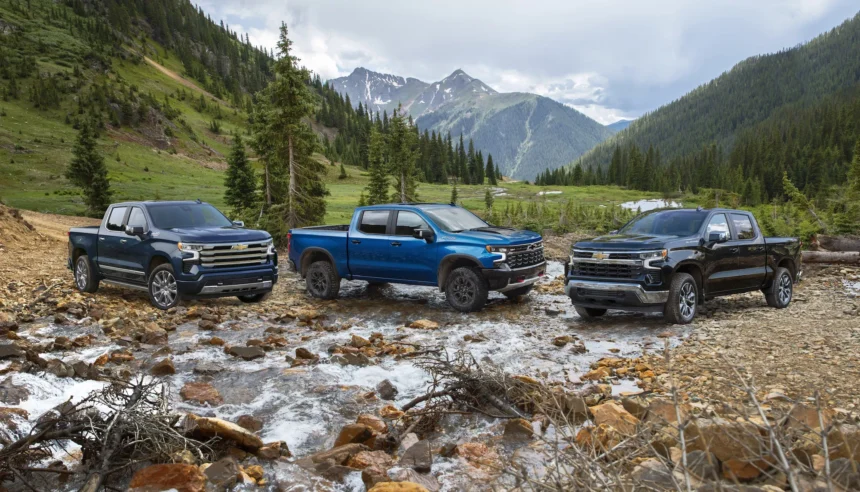Chevrolet Silverado: A Detailed Comparison
When it comes to choosing between the Chevrolet Silverado 1500 and GMC Sierra 1500 full-size pickup trucks, the differences can be as subtle as siblings from the same family or as distinct as polar opposites. While both trucks share many similarities, including engine options, cab sizes, bed lengths, and features, they each have their own unique characteristics that set them apart. Let’s take a closer look at the key differences between these two popular trucks to help you decide which one is the right choice for your needs.
The Chevy Silverado offers a wider range of trim levels, with nine options available from the basic work truck to the luxurious High Country trim. On the other hand, the GMC Sierra tends to have more refined interiors, advanced tech features, and upscale comfort amenities such as massaging seats. While both trucks offer a variety of configurations to suit different preferences, the choice between the two ultimately comes down to personal taste and priorities.
Sierra vs. Silverado Trims and Prices
- The Silverado lineup includes trim levels such as WT, Custom, LT, RST, LTZ, LT Trail Boss, and High Country, with prices ranging from $44,500 to $72,000.
- On the other hand, the Sierra offers trims like Pro, SLE, Elevation, SLT, Denali, AT4, AT4X, and Denali Ultimate, with prices ranging from $46,000 to $84,200.
- Additional features such as four-wheel drive, engine options, and bed lengths can impact the overall cost of each truck.
How Much is a GMC Sierra?
The GMC Sierra Pro starts at just under $40,000 and includes basic features like power windows, 17-inch steel wheels, and a 7.0-inch touchscreen with Apple CarPlay and Android Auto. As you move up the trim levels, you’ll find more premium amenities and advanced tech options, with the Denali Ultimate topping the lineup at $83,000.
Key highlights of the Sierra lineup include the SLE crew cab with a 12.3-inch digital instrument cluster, a 13.4-inch touchscreen, heated front seats, a heated steering wheel, and a variety of driver-assist features. The Denali Ultimate offers a powerful 6.2-liter V-8 engine, luxurious interior appointments, and advanced safety technologies.
How Much is a Silverado 1500?
The Silverado offers a similar range of trims and features, with prices starting at around $38,000 for the base WT model. While the Silverado lacks some of the premium amenities found in the Sierra, it still provides a comfortable and capable driving experience.
The Silverado LT trim is a solid choice for those seeking a good balance of features and value, with a price point of around $55,000 for a crew cab and short bed configuration. While the Silverado may not have all the bells and whistles of the Sierra, it still offers a competitive option in the full-size truck segment.
Both the Sierra and Silverado offer off-road variants that cater to adventurous drivers, with the Sierra AT4X and Silverado ZR2 Bison topping the lineup in terms of price and capability.
Conclusion
In summary, the choice between the GMC Sierra 1500 and Chevrolet Silverado 1500 ultimately comes down to personal preference and priorities. While the Sierra may offer more luxurious features and advanced technologies, the Silverado provides a solid option for those seeking a reliable and capable full-size truck.
Whether you prioritize comfort, performance, or value, both the Sierra and Silverado have something to offer. Take the time to explore each truck’s features and capabilities to determine which one best suits your needs and preferences.
The Silverado and Sierra are two popular pickup trucks from General Motors that offer impressive performance, payload capacity, and towing capabilities. Both trucks come with a variety of powertrain options, including gas and diesel engines, to suit different needs and preferences.
The Sierra AT4X, for example, comes standard with a turbodiesel engine, while the 6.2-liter V-8 is only available with four-wheel drive. The Silverado V-8 and turbodiesel engines can tow up to 13,300 pounds, which is more than the Sierra. The engine specs vary across the different models, with the turbo-4, turbodiesel inline-6, and V-8 engines offering different levels of horsepower and torque.
Both the Sierra and Silverado come with rear-wheel drive, but full-time four-wheel drive with a 2-speed transfer case is available on most models. The Trail Boss and AT4 models are designed for off-road adventures, with features like a factory lift, off-road suspension, locking differentials, and skid plates. The ZR2 takes it a step further with front and rear electronic locking differentials, front winches, and mud terrain tires.
In terms of towing capacity, the trucks can tow anywhere from 9,300 to 13,300 pounds depending on the engine and drivetrain configuration. The payload capacity ranges from 1,960 to 2,260 pounds, offering plenty of space for hauling cargo.
When it comes to fuel economy, the Sierra and Silverado have similar ratings, with slight variations due to differences in content and weight. The turbodiesel engine offers the best efficiency and towing capabilities, making it a good choice for those who do a lot of highway driving.
Overall, both the Sierra and Silverado offer impressive performance, payload capacity, and towing capabilities. The Silverado ZR2 has an edge in off-road performance, while the Sierra has a direct electric-assist power steering system for better handling. With a range of powertrain options and features, these trucks are versatile and capable for a variety of tasks. When it comes to the Sierra and Silverado, the beds may be a major competitive advantage, but let’s not overlook the significance of the crew cabs. These trucks offer a spacious interior with 43.4 inches of rear legroom, along with ample head, shoulder, and knee room. This generous space makes them ideal for families who need a versatile vehicle for both work and play.
Both the Sierra and Silverado make the most of their interior space, providing plenty of storage options such as deep center console bins, wide door pockets, center console trays, double glove compartments, and rear underseat storage. With so much room to spare, these trucks can easily accommodate all your gear and belongings without feeling cramped.
In terms of styling, the Sierra and Silverado each have their own unique look. The Silverado has a more subdued front end compared to the imposing Silverado HD, with daytime running lights that add a touch of sophistication. On the other hand, the Sierra sports boxed wheel arches and a variety of broad grilles that give it a rugged and stylish appearance, especially in the Denali trim.
When it comes to safety, both trucks offer good standard driver-assist technology and have earned a five-star rating from the NHTSA for crew cab models. However, both were dinged for frontal crash protection, and the NHTSA gave them a four-star rating for rollover risk. Despite these drawbacks, both models come with a range of safety features, including automatic emergency braking, active lane control, and automatic high beams.
In the end, the Sierra edges out the Silverado in terms of style and luxury, earning a higher TCC rating. While the Sierra Denali trim may cost more than its Silverado counterpart, it offers a premium driving experience with rich leather and wood trim that exudes luxury. Ultimately, the Sierra emerges as the winner in this comparison, but it’s worth the extra cost for those who value style and comfort in their truck. There are a lot of different types of articles out there, and writing a detailed article can be a challenging task. However, with the right approach and some planning, you can create an engaging and informative piece that will capture your readers’ attention.
When writing a detailed article, it’s important to start by doing thorough research on your topic. This may involve reading books, articles, and other sources of information to gather as much relevant information as possible. It’s also a good idea to conduct interviews with experts in the field to gain valuable insights and perspectives.
Once you have gathered all of your research, it’s time to outline your article. This will help you organize your thoughts and ensure that you cover all of the important points you want to make. Your outline should include an introduction, body paragraphs, and a conclusion.
In your introduction, you should provide a brief overview of the topic you will be discussing and explain why it is important. This will help set the stage for the rest of your article and give your readers a sense of what to expect.
In the body of your article, you should present the information you have gathered in a logical and organized manner. This may involve breaking your article up into sections or subheadings to make it easier for readers to follow along. Make sure to include plenty of examples, statistics, and other evidence to support your points.
Finally, in your conclusion, you should summarize the key points you have made in your article and reiterate why they are important. You may also want to offer some suggestions for further reading or research on the topic.
Overall, writing a detailed article requires careful planning, thorough research, and strong writing skills. By following these steps, you can create a compelling and informative piece that will engage your readers and leave a lasting impression.







